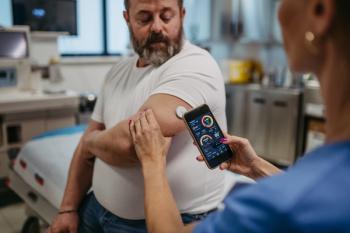
SCIg More Effective Immunoglobulin Option for Immunocompromised Patients With Inborn Errors of Immunity
Key Takeaways
- Immunocompromised patients with IEI receiving cSCIg had a lower viral infection rate compared with those on IVIG or fSCIg.
- The study found cSCIg had a 2.5% infection rate, whereas IVIG and fSCIg had rates of 4.2% and 4.4%, respectively.
Subcutaneous immunoglobulin was found to elicit fewer viral infections compared with other routes of immunoglobulin replacement therapy, including intravenous immunoglobulin.
Immunocompromised patients with inborn errors of immunity (IEI) receiving immunoglobulin replacement therapy (IRT) through conventional subcutaneous immunoglobulin (cSCIg) had a reduced incidence of viral infections compared with those receiving intravenous immunoglobulin (IVIG) and facilitated SCIg (fSCIg), according to the results of a cross-sectional study published by investigators in the European Journal of Pediatrics.1
Varying IRT Routes Necessitate Comparison of Viral Infection Incidence
Often considered rare, IEIs are monogenic disorders of the immune system that can cause immunodeficiency, autoinflammation, allergy, and/or cancer. IEIs comprise hundreds of genetic disorders and generally increase patient susceptibility to infections. Challenges abound with the management of patients with IEIs, given their complex nature and the lack of specialized medicines for use in treatment. However, IRT has emerged as a standard of care for immunodeficiencies that emerge with impaired antibody production.2,3
IVIG and SCIg are the most common routes of immunoglobulin, and each has comparable efficacy while carrying their respective limitations. Intravenous (IV) administration allows for higher quantities of immunoglobulin G (IgG) than other routes, which is notable given the strong inverse correlation between IgG concentration and infection risk. However, IVIG infusions require major disruptions to quality of life, and IV access can be problematic for many. SCIg, on the other hand, can be administered at home and comes with less risk of adverse events (AEs), but with less treatment infused than IVIG.1,4
There are also differences in routes of SCIg. fSCIg delivers large volumes of serum IgG with minimal needle insertions, while cSCIg often involves weekly subcutaneous injections to avoid fluctuations in IgG threshold levels. With many options available for treatment providers, it is imperative for investigators to further evaluate not only the safety and efficacy of various Ig administration routes but also the differences in incidence of viral infections between routes.1,5
Conventional SCIg Has Lower Infection Incidence Compared With IVIG
In this current study, the investigators compared the incidence of viral infections in immunocompromised patients with IEI who received IRT through different routes from January 2023 to March 2023. The trial included 58 patients with IEI who had been receiving IRT for an extended period. Patients had their symptoms and incidence of infection assessed and were divided into groups based on receiving IVIG, cSCIg, and fSCIg.1
According to the investigators, the most common IRT route was IVIG, utilized by 55.1% (n = 32) of patients, followed by cSCIG (27.5%, n = 16). All IVIG treatments were administered to patients in the hospital, while cSCIg and fSCIg infusions were administered at home. Viral infection rates were calculated by the investigators through analysis of PCR results of each specified infection in every patient, along with the number of infections, over 3 months. They found an overall viral infection frequency of 3.79% (55 infections out of 1450 evaluations).1
For analysis of each IRT route, the IVIG route had an infection rate of 4.2%, while the SCIg route had a rate of 2.5% and the fSCIg route had a rate of 4.4%. Among each of the Ig treatment groups, the fewest viral infections were seen in patients treated with cSCIg (P < .05). For patients using fSCIg or IVIG, infections were typically detected in the third and fourth weeks. The most observed infections were due to adenovirus (21.8%), influenza A (16.4%), and human rhinovirus/enterovirus (16.4%), the investigators found.1
Overall, and consistent with previous findings, the data indicate that immunocompromised patients may benefit most from IRT through cSCIg, which had the lowest rate of viral infections in the study. cSCIg therapy reduced the incidence of viral infections by 50% compared with other routes of administration, with serum IgG levels being maintained throughout the process. Health care providers should ensure they monitor IgG levels throughout IRT and appropriately manage any AEs that may develop.1
“This study suggests that cSCIg treatment is a more effective treatment option for immunocompromised patients prone to viral infection,” the investigators wrote in their conclusion. “Still, it is also a safe method to administer due to the optimum IgG threshold level and quality of life score it provides.”1
REFERENCES
1. Kose H, Ozkan G, Simsek A, et al. Comparison of the frequency of viral infections in patients with inborn errors of immunity receiving immunoglobulin by different routes. Eur J Pediatr. 2025;184(373). doi:10.1007/s00431-025-06201-w
2. Bousfiha A, Moundir A, Tangye SG, et al. The 2022 update of IUIS phenotypical classification for human inborn errors of immunity. J Clin Immunol. 2022;42:1508-1520. doi:10.1007/s10875-022-01352-z
3. Akalu YT, Bogunovic D. Inborn errors of immunity: an expanding universe of disease and genetic architecture. Nat Rev Genet. 2024;25:184-195. doi:10.1038/s41576-023-00656-z
4. Wasserman RL. Progress in gammaglobulin therapy for immunodeficiency: From subcutaneous to intravenous infusions and back again. J Clin Immunol. 2021;32:1153-1164. doi:10.1007/s10875-012-9740-x
5. Hustad NB, Degerud HM, Hjelmerud I, et al. Real-world experiences with facilitated subcutaneous immunoglobulin substitution in patients with hypogammaglobulinemia, using a three-step ramp-up schedule. Front Immunol. 2021;12. doi:10.3389/fimmu.2021.670547
Newsletter
Stay informed on drug updates, treatment guidelines, and pharmacy practice trends—subscribe to Pharmacy Times for weekly clinical insights.




















































































































































































































